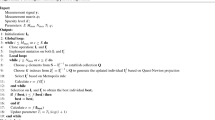Abstract
A low complexity scheme is developed to design the sparse linear phase FIR filters based on the improved iteratively re-weighted orthogonal matching pursuit(OMP) algorithm. The scheme employs the Frobenius norm to simplify searching for the desired sparse FIR filter at each iteration. Furthermore, a log function is introduced to enhance the weight updating process at each iteration. The simulation results demonstrate that our scheme can effectively generate the sparse linear phase FIR filters which satisfy the various given design specifications.




Similar content being viewed by others
References
T. Bensouici, A. Charef, A. Imen, A simple design of fractional delay FIR filter based on binomial series expansion theory. Circuits Syst. Signal Process. 38, 3356–3369 (2019). https://doi.org/10.1007/s00034-018-1000-8
T. Baran, D. Wei, A.V. Oppenheim, Linear programming algorithms for sparse filter design. IEEE Trans. Signal Process. 58, 1605–1617 (2010). https://doi.org/10.1109/TSP.2009.2036471
W. Chen, M. Huang, X. Lou, Design of sparse FIR filters with reduced effective length. IEEE Trans. Circuits Syst. I Regul. Pap. 66, 1496–1506 (2019). https://doi.org/10.1109/TCSI.2018.2883965
A.K. Dwivedi, S. Ghosh, N.D. Londhe, Review and analysis of evolutionary optimization-based techniques for FIR filter design. Circuits Syst. Signal Process. 37, 4409–4430 (2018). https://doi.org/10.1007/s00034-018-0772-1
K. Ichige, M. Iwaki, R. Ishii, Accurate estimation of minimum filter length for optimum FIR digital filters. IEEE Trans. Circuits Syst. II Analog Digit. Signal Process. 47, 1008–1016 (2000). https://doi.org/10.1109/82.877143
A. Jiang, H.K. Kwan, Y. Zhu, X. Liu, N. Xu, Y. Tang, Design of sparse FIR filters with joint optimization of sparsity and filter order. IEEE Trans. Circuits Syst. I Regul. Pap. 62, 195–204 (2015). https://doi.org/10.1109/TCSI.2014.2354771
W. Xu, J. Zhao, C. Gu, Design of linear-phase FIR multiple-notch filters via an iterative reweighted OMP scheme. IEEE Trans. Circuits Syst. II Express Briefs 61, 813–817 (2014). https://doi.org/10.1109/TCSII.2014.2345299
L. Yu, J. Zhao, Hybrid optimisation method of sparse FIR DFEs based on reweighted l1 norm minimisation and greedy algorithms. Electron. Lett. 55, 491–493 (2019). https://doi.org/10.1049/el.2018.7438
L. Zheng, A. Jiang, H. K. Kwan. Sparse FIR filter design via partial l1 optimization. In 2017 IEEE International Symposium on Circuits and Systems. Baltimore, MD, USA. 28 September 2017. https://doi.org/10.1109/ISCAS.2017.8050776
Funding
This work was supported by the National Natural Science Foundation of China (Grant No. 61771262).
Author information
Authors and Affiliations
Contributions
All authors contributed to the study conception and design. Material preparation, derivation of formula, Programming and analysis were performed by Yi Li, Jiaxiang Zhao, Wei Xu and Guiling Sun. The first draft of the manuscript was written by Yi Li and all authors commented on previous versions of the manuscript. All authors read and approved the final manuscript.
Corresponding author
Ethics declarations
Conflict of interest
The authors declare that they have no conflict of interest.
Additional information
Publisher's Note
Springer Nature remains neutral with regard to jurisdictional claims in published maps and institutional affiliations.
Appendix
Appendix
Rights and permissions
About this article
Cite this article
Li, Y., Zhao, J., Xu, W. et al. A Low Computational Complexity Scheme for Designing Linear Phase Sparse FIR Filters. Circuits Syst Signal Process 41, 1550–1562 (2022). https://doi.org/10.1007/s00034-021-01836-0
Received:
Revised:
Accepted:
Published:
Issue Date:
DOI: https://doi.org/10.1007/s00034-021-01836-0




